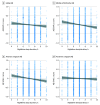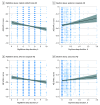Association of Sleep and β-Amyloid Pathology Among Older Cognitively Unimpaired Adults
- PMID: 34297074
- PMCID: PMC8303100
- DOI: 10.1001/jamanetworkopen.2021.17573
Association of Sleep and β-Amyloid Pathology Among Older Cognitively Unimpaired Adults
Abstract
Importance: Disrupted sleep commonly occurs with progressing neurodegenerative disease. Large, well-characterized neuroimaging studies of cognitively unimpaired adults are warranted to clarify the magnitude and onset of the association between sleep and emerging β-amyloid (Aβ) pathology.
Objective: To evaluate the associations between daytime and nighttime sleep duration with regional Aβ pathology in older cognitively unimpaired adults.
Design, setting, and participants: In this cross-sectional study, screening data were collected between April 1, 2014, and December 31, 2017, from healthy, cognitively unimpaired adults 65 to 85 years of age who underwent florbetapir F 18 positron emission tomography (PET), had APOE genotype information, scored between 25 and 30 on the Mini-Mental State Examination, and had a Clinical Dementia Rating of 0 for the Anti-Amyloid Treatment in Asymptomatic Alzheimer Disease (A4) Study. Data analysis was performed from December 1, 2019, to May 10, 2021.
Exposures: Self-reported daytime and nighttime sleep duration.
Main outcomes and measures: Regional Aβ pathology, measured by florbetapir PET standardized uptake value ratio.
Results: Amyloid PET and sleep duration information was acquired on 4425 cognitively unimpaired participants (mean [SD] age, 71.3 [4.7] years; 2628 [59.4%] female; 1509 [34.1%] tested Aβ positive). Each additional hour of nighttime sleep was associated with a 0.005 reduction of global Aβ standardized uptake value ratio (F1, 4419 = 5.0; P = .03), a 0.009 reduction of medial orbitofrontal Aβ (F1, 4419 = 17.4; P < .001), and a 0.011 reduction of anterior cingulate Aβ (F1, 4419 = 15.9; P < .001). When restricting analyses to participants who tested Aβ negative, nighttime sleep was associated with a 0.006 reduction of medial orbitofrontal Aβ (F1,2910 = 16.9; P < .001) and a 0.005 reduction of anterior cingulate Aβ (F1,2910 = 7.6; P = .03). Daytime sleep was associated with a 0.013 increase of precuneus Aβ (F1,2910 = 7.3; P = .03) and a 0.024 increase of posterior cingulate Aβ (F1,2910 = 14.2; P = .001) in participants who tested Aβ negative.
Conclusions and relevance: In this cross-sectional study, the increased risk of Aβ deposition with reduced nighttime sleep duration occurred early, before cognitive impairment or significant Aβ deposition. Daytime sleep may be associated with an increase in risk for early Aβ accumulation and did not appear to be corrective for loss of nighttime sleep, demonstrating a circadian rhythm dependence of sleep in preventing Aβ accumulation. Treatments that improve sleep may reduce early Aβ accumulation and aid in delaying the onset of cognitive dysfunction associated with early Alzheimer disease.
Conflict of interest statement
Figures



References
Publication types
MeSH terms
Substances
Grants and funding
LinkOut - more resources
Full Text Sources
Medical
Miscellaneous

